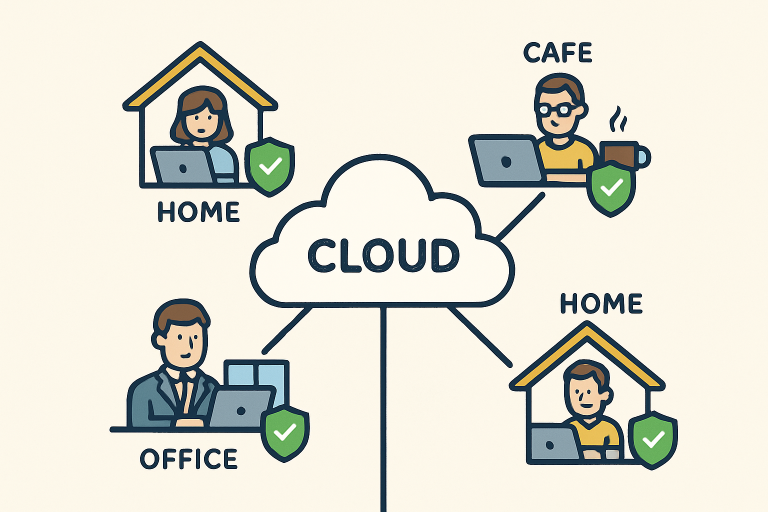Introduction
The rapid transformation of global workforces has placed remote work at the forefront for businesses of all sizes. With employees connecting from home offices, cafés, and nearly anywhere in the world, traditional network security strategies centered on a physical office are no longer sufficient. Today’s organizations need next-generation solutions that extend robust, consistent protection wherever employees work, without slowing them down. This has brought attention to SASE network security, a cloud-native approach designed to meet the challenges of a distributed digital workforce.
SASE reimagines security by bringing it closer to users and the cloud services they use, reducing complexity and risk. Businesses now require platforms that deliver both seamless application access and comprehensive, layered protection, regardless of location or device. As organizations adapt to these changing requirements, understanding how SASE functions and the benefits it offers can be a game-changer. The appeal of SASE lies in its ability to consolidate and simplify network security for remote work, bolstering defense against ever-evolving cyber threats. Its scalable model is especially beneficial for businesses growing their remote or hybrid workforce. By deploying security and connectivity in tandem, SASE efficiently aligns with today’s virtual and fast-evolving office landscape. To fully grasp how SASE is guiding the future of remote work, it’s essential to delve into its architecture, how it operates, and why adopting this solution is a vital step for future-ready organizations.
Understanding SASE
SASE, or Secure Access Service Edge, is an architecture that merges wide-area networking (WAN) and multiple security functions into a single, integrated cloud-based service. By moving security tools, including secure web gateways, firewall-as-a-service, cloud access security brokers (CASB), and zero-trust network access (ZTNA), to the network edge, businesses can enforce policies consistently and ensure all endpoints are protected. The SASE model differs from traditional security methods that rely on data center-centric traffic patterns. Instead, cloud-deployed SASE dynamically applies protection regardless of network entry point, which is particularly valuable as more services migrate to cloud platforms like Microsoft 365 and Google Workspace. With SASE, access management, traffic inspection, and threat response are unified on a single platform, streamlining management and reducing coverage gaps.
 The Role of SASE in Remote Work
The Role of SASE in Remote Work
Modern remote work demands IT solutions that go beyond what traditional VPNs and perimeter defenses can offer. SASE solves this challenge by pushing security enforcement closer to users, wherever they are located. This proximity reduces latency, resulting in faster, more reliable connections for remote employees accessing sensitive corporate resources. Because SASE is inherently cloud-native and scalable, it enables businesses to adapt quickly to organizational changes, such as onboarding new staff or supporting satellite offices, without additional hardware investment or an overhaul of network architecture. This flexibility is essential for companies with globally distributed teams that need to remain productive and secure at all times.
Zero Trust Security and SASE
Zero Trust is a cornerstone of SASE architecture, operating under the principle that no user or device, inside or outside the corporate network, should be automatically trusted. Instead, continuous identity verification and real-time assessment of device posture are required each time access is requested. This “never trust, always verify” approach minimizes the risk of breaches, especially in environments where endpoints are outside direct IT control.
By embedding Zero Trust within SASE, organizations ensure that every access attempt is scrutinized, policies are consistently enforced, and threats are detected before they escalate. This highly adaptive model is particularly adept at safeguarding sensitive data in remote work scenarios, where devices and users frequently change locations and contexts.
Benefits of SASE for Organizations
- Enhanced Security: SASE consolidates protection features such as threat detection, data loss prevention, and secure web access under a unified set of policies and monitoring tools. This broad coverage reduces risks associated with patchwork legacy solutions and misconfigurations.
- Improved Performance: By routing traffic through optimized cloud networks, SASE eliminates the bottlenecks of traditional backhauling through centralized data centers, resulting in lower latency and a smoother user experience.
- Simplified Management: Centralized management dashboards help IT teams deploy, monitor, and maintain security policies globally, reducing administrative burden and response times.
- Cost Efficiency: Adopting SASE can decrease the need for on-premises hardware and separate service vendors, delivering both direct savings and lower maintenance overhead.
Real-World Implementations
Organizations across industries have realized tangible gains by embracing SASE. In healthcare, for example, one provider utilized SASE to oversee hundreds of remote nurses, ensuring only authorized access to sensitive patient data. This approach enabled real-time monitoring and rapid incident response without placing physical appliances at every remote location.
Similarly, many financial institutions have adopted SASE to quickly scale up secure remote work for their staff during times of rapid change or crisis, minimizing operational disruption while maintaining compliance with strict industry regulations.
Future Trends in SASE and Remote Work
The evolution of SASE will continue, fueled by technological advances such as artificial intelligence (AI) and machine learning (ML), which promise to boost threat detection and automate security responses. The emergence of 5G connectivity will also enhance the remote work experience by providing faster, more stable connections, pairing perfectly with SASE platforms optimized for the cloud.
As businesses increasingly adopt hybrid work models, the demand for solutions that natively integrate security, networking, and seamless remote access will surge. Forward-looking IT leaders will leverage these innovations to support resilient, secure operations that adapt to wherever and however their employees work.
Conclusion
Remote work is here to stay, and organizations must evolve their security strategies to safeguard their distributed workforce. SASE stands out as a comprehensive, cloud-first framework that brings together advanced networking and robust, adaptive security. By embracing SASE, companies can empower their remote teams with the tools and protection they need to be productive, collaborative, and secure—now and in the future.




